Hyacinths are cherished by gardeners for their stunning blooms and captivating fragrance. These perennial bulbs belong to the Asparagaceae family and are native to the eastern Mediterranean, particularly regions like Turkey, Syria, and Lebanon. The name “hyacinth” is derived from Greek mythology, where Hyacinthus was a beautiful youth adored by the god Apollo. Today, hyacinths are celebrated for their dense clusters of flowers that bloom in early to mid-spring, showcasing a spectrum of colors, including shades of blue, purple, pink, white, and yellow. Their vibrant presence and historical significance make hyacinths a timeless addition to any garden.
Benefits of Growing Hyacinths
Planting hyacinths offers numerous benefits, both aesthetic and practical. One of the primary advantages is their strong, sweet fragrance, which can fill a garden with a delightful scent. This makes hyacinths ideal for planting near windows, along walkways, or in areas where their aroma can be fully appreciated. In addition to their fragrance, hyacinths provide a burst of vibrant color that can enhance the visual appeal of any garden. They are relatively low-maintenance plants that, once established, require minimal care. Hyacinths are also excellent for indoor forcing, allowing gardeners to enjoy their beauty and fragrance inside the home during the colder months.
Popular Hyacinth Varieties
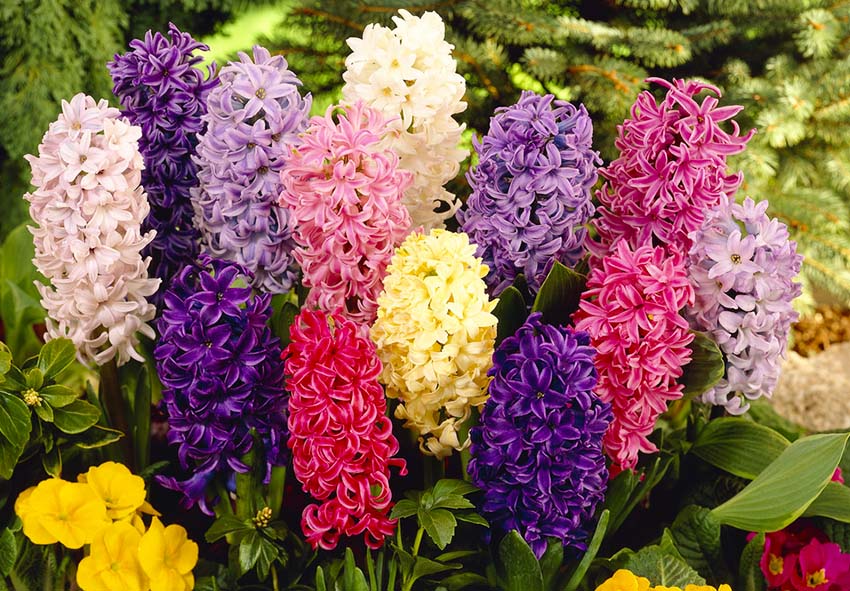
There are several popular varieties of hyacinths, each with unique characteristics and charm. Dutch hyacinths are the most common and are known for their large, dense flower spikes and vibrant colors. These hyacinths are typically grown from bulbs and can be planted in both garden beds and containers. Roman hyacinths, or Hyacinthus orientalis var. albulus, are less common but equally beautiful, with looser, more delicate flower spikes in softer shades of pink, white, and blue. Roman hyacinths are particularly well-suited for naturalizing in meadows or woodland gardens due to their more subtle appearance.
Grape hyacinths, or Muscari spp., are not true hyacinths but are often grouped with them due to their similar appearance and spring blooming period. These small bulbs produce clusters of tiny, bell-shaped flowers resembling grapes, typically in shades of blue or purple, and are excellent for borders, rock gardens, and naturalizing in lawns.
Choosing the Right Hyacinth for Your Garden
Selecting the right hyacinth variety for your garden depends on several factors, including climate, soil conditions, and garden design. Hyacinths thrive in temperate climates with cold winters necessary for the bulbs to develop properly.
| Variety | Bloom Time | Fragrance | Height | Ideal for Containers | Frost Resistance |
| Dutch Hyacinths | Early to mid-spring | Yes | 8-12 inches | Yes | High |
| Roman Hyacinths | Early spring | Mild | 6-8 inches | Yes | Moderate |
| Grape Hyacinths | Mid to late spring | No | 6-8 inches | Yes | Low |
| Wood Hyacinths | Late spring to early summer | Mild | 12-18 inches | No | Moderate |
By understanding the different hyacinth varieties and selecting the right ones for your garden, you can enjoy a stunning and fragrant display of these beautiful spring flowers. Whether you’re looking to add a pop of color to your garden beds or create a fragrant pathway, hyacinths are a versatile and rewarding choice for any gardener.
Planting Hyacinths
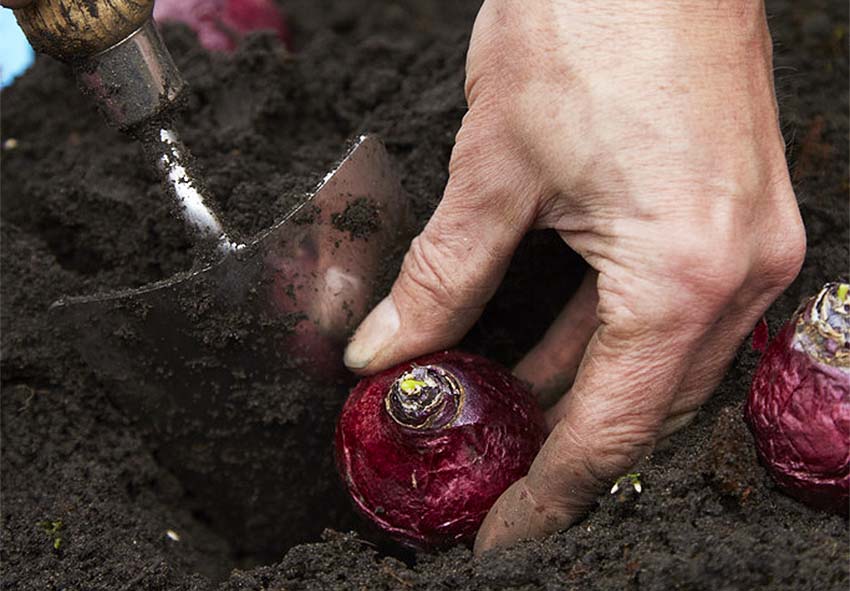
First of all, planting hyacinths is a straightforward process that, when done correctly, yields beautiful and fragrant spring blooms. To achieve the best results, it’s important to plant the bulbs at the right time, prepare the soil adequately, and follow proper planting techniques.
When to Plant Hyacinths
To ensure successful growth and blooming, it’s crucial to plant hyacinth bulbs at the right time. In temperate climates, the best time to plant hyacinths is in the fall, typically between September and November, before the first hard frost. This timing allows the bulbs to establish roots before winter sets in, ensuring robust blooms in the spring. In warmer climates, where winters are milder, you may need to pre-chill the bulbs in the refrigerator for about 6-8 weeks before planting to simulate the cold period they require for proper development. Plant the bulbs as soon as possible after chilling, ideally in late fall.
Soil Preparation for Hyacinths
Creating the right soil environment is essential for the healthy growth of hyacinths. These bulbs prefer well-drained soil rich in organic matter. Start by selecting a sunny or partially shaded location with good drainage. Poorly drained soil can lead to bulb rot, a common problem for hyacinths. If your soil is heavy clay, consider amending it with sand or grit to improve drainage. Additionally, mix in compost or well-rotted manure to enhance soil fertility and structure. Aim for a soil pH between 6.0 and 7.0, slightly acidic to neutral, which is ideal for hyacinths. Testing your soil’s pH and making necessary adjustments can significantly improve your plants’ performance.
Planting Techniques for Hyacinths
Proper planting techniques are key to ensuring healthy and vibrant hyacinth blooms. Follow these step-by-step instructions for best results:
- Choose Quality Bulbs: Select firm, healthy bulbs free from mold or damage. Larger bulbs generally produce more substantial flower spikes.
- Planting Depth and Spacing: Dig holes to a depth of about 6-8 inches, approximately three times the height of the bulb. Space the bulbs about 4-6 inches apart to allow for adequate airflow and growth.
- Positioning the Bulbs: Place each bulb in the hole with the pointed end facing up and the roots facing down. Gently press the bulb into the soil to ensure good contact.
- Covering the Bulbs: Fill the hole with soil, pressing it down lightly to eliminate air pockets. Water the area thoroughly after planting to help settle the soil around the bulbs.
- Mulching: Apply a layer of mulch, such as straw or shredded leaves, over the planting area to help retain moisture and provide insulation during the winter months.
- Watering Requirements: Water the bulbs thoroughly after planting. During the growing season, keep the soil consistently moist but not waterlogged. Avoid overhead watering to reduce the risk of fungal diseases.
By following these planting guidelines, you can create an optimal environment for your hyacinths to thrive. Whether planted in garden beds, borders, or containers, well-cared-for hyacinth bulbs will reward you with a stunning display of colorful, fragrant blooms in the spring.
Caring for Hyacinths
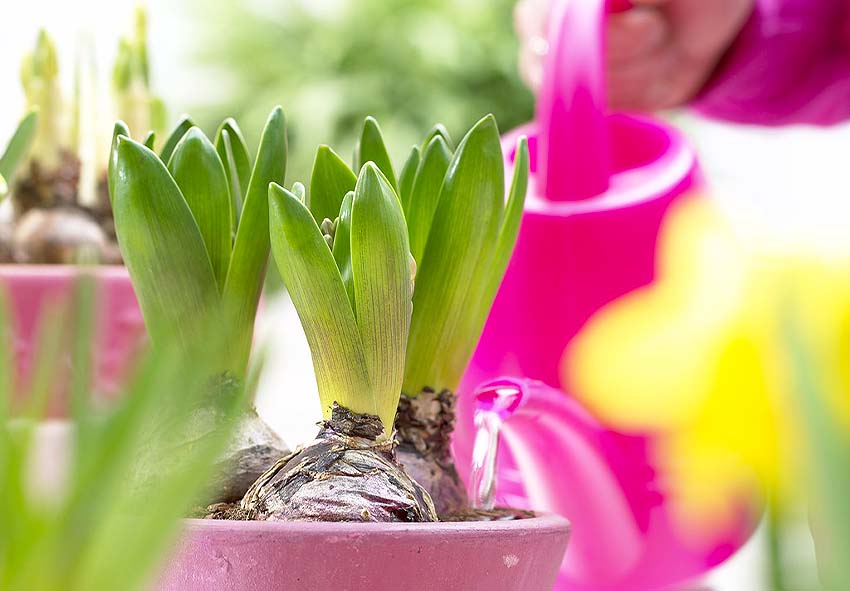
Proper care is essential for maintaining the health and beauty of hyacinths throughout their growing season. From watering and fertilizing to pruning and deadheading, each step plays a crucial role in ensuring your hyacinths thrive and produce vibrant blooms year after year. Equally important is the stage of hyacinth care after flowering.
Watering Hyacinths
Hyacinths require consistent moisture to thrive, but it’s important to avoid waterlogged soil, which can lead to bulb rot. Water newly planted bulbs thoroughly after planting to help them establish roots. During the growing season, water hyacinths regularly, keeping the soil consistently moist but not soggy. Aim to water deeply once a week, allowing the soil to dry out slightly between waterings. In periods of dry weather, increase the frequency of watering to prevent the soil from drying out completely. Always water at the base of the plants to avoid wetting the foliage, which can help prevent fungal diseases.
Fertilizing Hyacinths
Feeding your hyacinths with the right nutrients is key to promoting healthy growth and vibrant blooms. Apply a balanced, slow-release fertilizer at the time of planting to provide essential nutrients. As the plants grow, you can apply a liquid fertilizer every two weeks during the active growing season, typically from early spring until the flowers fade. Choose a fertilizer high in phosphorus, which supports strong root development and flower production. Avoid over-fertilizing, as excessive nutrients can lead to lush foliage at the expense of flower production. Following these guidelines will help ensure your hyacinths receive the necessary nutrients for optimal growth and blooming.
Pruning and Deadheading Hyacinths
Pruning and deadheading are important maintenance tasks that can extend the blooming period and encourage new growth. After the flowers have bloomed and started to fade, use sharp, clean scissors or pruning shears to remove spent blooms. This process, known as deadheading, prevents the plant from expending energy on seed production and encourages it to focus on developing strong bulbs for the next season. Leave the foliage intact until it turns yellow and dies back naturally, as this allows the plant to photosynthesize and store energy in the bulbs for the following year. Once the foliage has withered, you can trim it back to ground level. Regular pruning and deadheading will keep your hyacinths healthy and vigorous, ensuring a beautiful display of flowers each spring.
Hyacinth Problems and Solutions
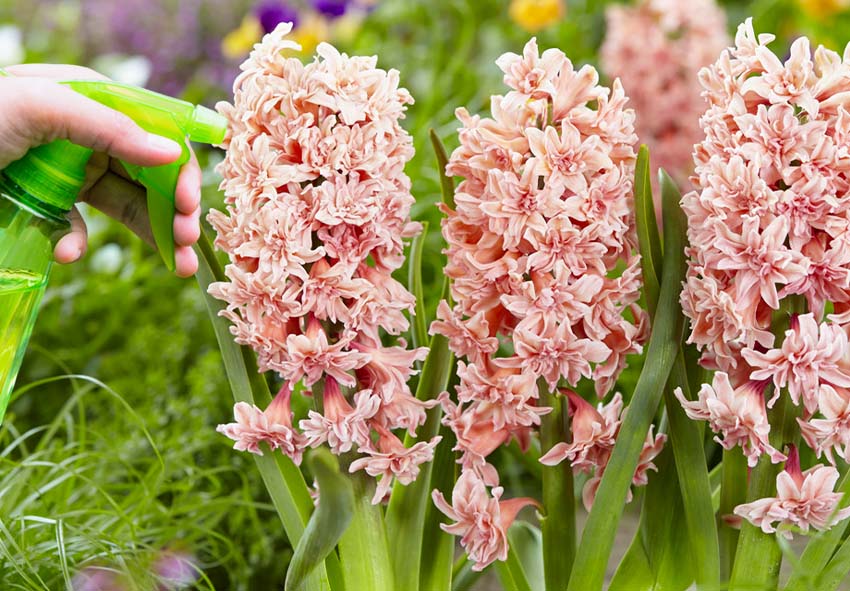
While hyacinths are relatively hardy and easy to grow, they can still fall victim to various pests, diseases, and growing issues. Understanding how to identify and address these problems can help keep your plants healthy and blooming beautifully.
Common Pests and Diseases
Hyacinths can be affected by a variety of pests and diseases, which can compromise their health and appearance.
- Aphids: These small, sap-sucking insects can cause deformed leaves and flowers. Aphids also excrete honeydew, which can lead to sooty mold. To control aphids, spray your plants with a strong jet of water to dislodge them or use insecticidal soap.
- Narcissus Bulb Fly: The larvae of this fly can burrow into hyacinth bulbs, causing them to rot. Affected bulbs may fail to produce flowers or produce weak, deformed plants. To prevent infestations, inspect bulbs before planting and avoid planting in areas where bulb flies have been a problem.
- Botrytis Blight: Also known as gray mold, this fungal disease causes brown, water-soaked spots on leaves and flowers, which eventually become covered in gray mold. To manage botrytis blight, ensure good air circulation around your plants, avoid overhead watering, and remove any affected plant parts promptly.
- Basal Rot: This fungal disease causes bulbs to decay from the base, leading to stunted growth or failure to emerge. Prevent basal rot by planting bulbs in well-drained soil and avoiding overwatering. If you notice symptoms, remove and destroy affected bulbs to prevent the spread of the disease.
Troubleshooting Hyacinth Issues
Several common issues can affect hyacinths, leading to symptoms such as wilting, yellowing leaves, or lack of blooms. Here are some solutions to these problems:
- Wilting: Wilting can be caused by a variety of factors, including underwatering, overwatering, or root damage. Ensure that your hyacinths receive consistent moisture, but do not allow the soil to become waterlogged. Check for signs of root rot or damage and adjust your watering practices accordingly.
- Yellowing Leaves: Yellow leaves can be a sign of nutrient deficiencies, particularly nitrogen, or poor drainage. Test your soil and amend it with compost or a balanced fertilizer if necessary. Improve drainage by adding sand or grit to heavy soils.
- Lack of Blooms: If your hyacinths fail to bloom, it could be due to insufficient chilling, poor soil conditions, or overcrowding. Ensure that bulbs receive the necessary cold period (either through natural winter conditions or artificial chilling) and are planted in well-drained, fertile soil. If bulbs are overcrowded, divide and replant them to give each bulb enough space to grow.
By understanding and addressing these common pests, diseases, and growing issues, you can maintain healthy hyacinths that will reward you with beautiful blooms each spring. Regular monitoring and proactive care are key to preventing problems and ensuring your plants thrive.
Hyacinth Care Throughout the Seasons
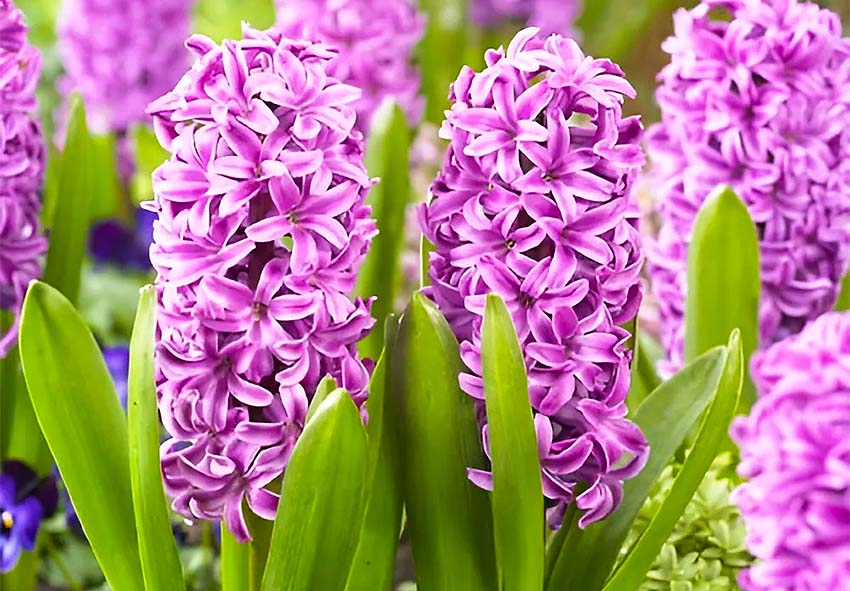
Hyacinths require specific care throughout the year to ensure they remain healthy and produce beautiful blooms each spring. By understanding the seasonal needs of your hyacinths, you can provide the appropriate care and maintenance at each stage of their growth cycle.
- Spring Care
Spring is the season when hyacinths burst into bloom, providing a vibrant display of color and fragrance in your garden. As soon as the shoots emerge, start watering your hyacinths regularly. Keep the soil consistently moist but not waterlogged. Apply a balanced, slow-release fertilizer when the shoots first appear to promote strong growth and vibrant flowers. Remove spent blooms to prevent the plant from expending energy on seed production. This will encourage the bulbs to store energy for the next growing season. Keep the area around your hyacinths free of weeds to reduce competition for nutrients and water.
- Summer Care
During the summer months, hyacinths enter a period of dormancy, and their foliage begins to die back. Reduce watering as the foliage starts to yellow and die back. Once the foliage has completely died, stop watering altogether. Allow the foliage to die back naturally, as it helps the bulbs store energy for the next season. Only remove the foliage once it has turned brown and withered. Keep an eye out for pests such as bulb flies and aphids. Address any infestations promptly using appropriate pest control methods.
- Fall Care
Fall is the time to prepare your hyacinths for the upcoming winter and ensure they have the best start for the next growing season. If you are planting new hyacinth bulbs, do so in the fall, about 6-8 weeks before the first hard frost. This allows the bulbs to establish roots before winter. Amend the soil with compost or well-rotted manure to improve fertility and drainage. Apply a layer of mulch over the planting area to insulate the bulbs and protect them from extreme temperature fluctuations. This also helps retain moisture and suppress weeds. In areas with harsh winters, consider covering your hyacinth beds with a thicker layer of mulch or using frost cloths to provide additional protection from freezing temperatures.
- Winter Care
During the winter months, hyacinth bulbs are dormant and require protection to ensure they survive the cold season. If you live in a region with mild winters, your hyacinths can remain in the ground with a layer of mulch for protection. In colder climates, consider lifting the bulbs and storing them in a cool, dry place to prevent them from freezing. Periodically check stored bulbs for signs of rot or disease and discard any that appear damaged. For regions with warm winters, pre-chill bulbs in the refrigerator for 6-8 weeks before replanting in late winter or early spring to simulate the necessary cold period for blooming.
Creative Uses for Hyacinths
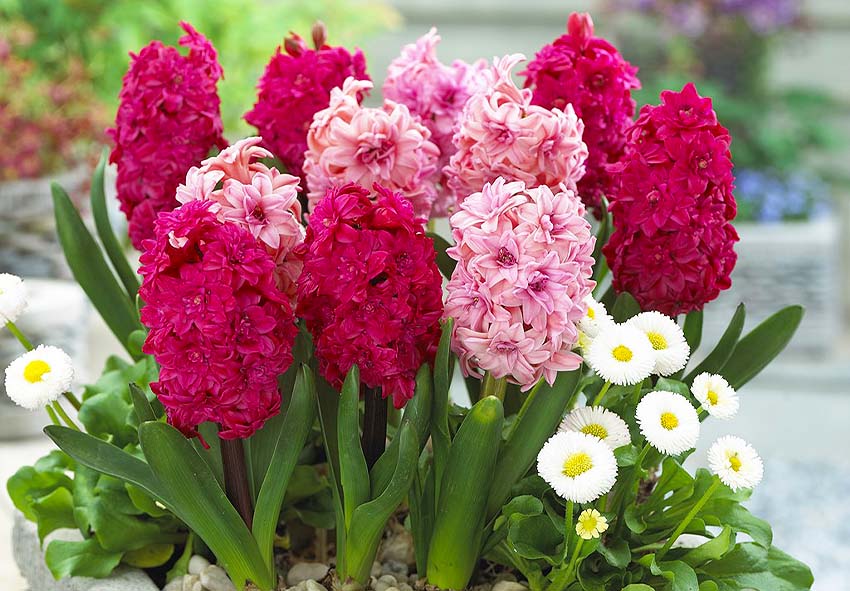
Hyacinths are versatile and stunning flowers that can be used in various creative ways to enhance the beauty of your garden and home. From landscaping to floral arrangements, these fragrant blooms offer numerous possibilities.
Hyacinths in Landscaping
Incorporating hyacinths into your garden design can add vibrant color and delightful fragrance to your landscape. Here are some ideas for using hyacinths in your garden:
- Borders and Edging: Plant hyacinths along garden borders or pathways to create a colorful and fragrant edge. Their uniform height and dense flower spikes make them perfect for defining garden spaces.
- Mass Plantings: For a dramatic display, plant hyacinths in large groups or drifts. This approach works well in flower beds or under trees and shrubs, creating a sea of color in the spring.
- Mixed Beds: Combine hyacinths with other spring-blooming bulbs such as tulips, daffodils, and crocuses. This mix of flowers can create a visually stunning and diverse display.
- Containers and Pots: Hyacinths are also excellent for container gardening. Plant them in pots or window boxes to brighten up patios, balconies, and entranceways. Containers allow you to move the plants to different locations to enjoy their beauty up close.
Hyacinths in Floral Arrangements
Hyacinths make beautiful additions to indoor floral arrangements, bringing their delightful fragrance and vibrant colors inside. When cutting hyacinths for floral arrangements, choose stems with partially opened flowers for longer-lasting blooms. Cut the stems at an angle and place them in water immediately. Combine hyacinths with other spring flowers such as tulips, daffodils, and irises. Their rich colors and sweet scent complement a variety of other blooms. Use them as the focal point in your arrangements, surrounded by complementary flowers and greenery.
Hyacinths look stunning in clear glass vases that showcase their vibrant stems and blooms. You can also use decorative ceramic or metal containers to add an extra touch of style to your arrangements. To keep hyacinth arrangements fresh, change the water every two days and trim the stems slightly each time. This helps prevent bacterial growth and extends the life of the flowers.
Extending the Blooming Season
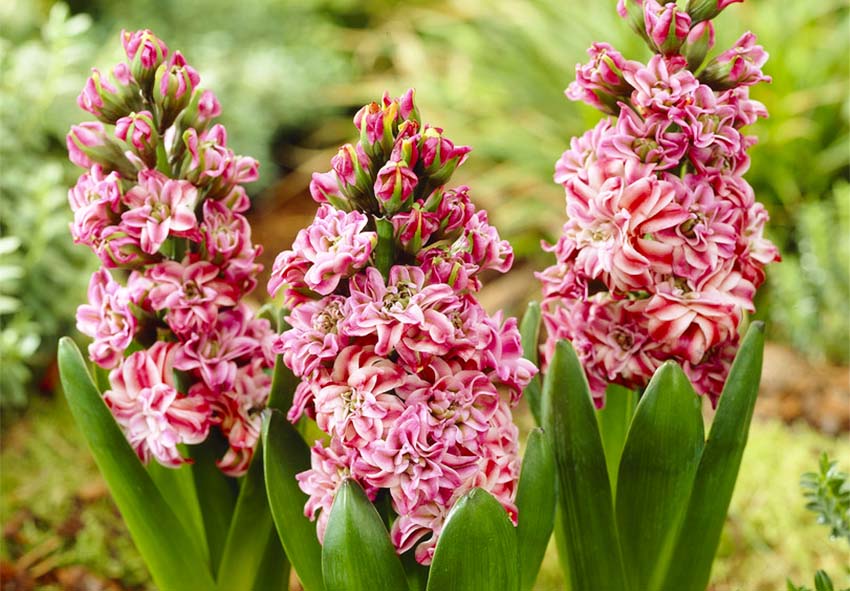
While hyacinths naturally have a relatively short blooming period, there are several ways to prolong their display through proper care and maintenance:
- Succession Planting: Plant hyacinth bulbs at intervals of one to two weeks in the fall. This staggered planting will result in a succession of blooms, extending the overall blooming period in your garden.
- Cool Storage: Store hyacinth bulbs in a cool, dark place before planting to ensure they receive the necessary chilling period. This can help delay blooming and extend the display time.
- Protecting from Heat: Hyacinths can fade quickly in hot weather. Plant them in a location with partial shade to protect them from intense midday sun, which can prolong their blooming period.
- Proper Watering and Feeding: Keep the soil consistently moist and feed hyacinths with a balanced fertilizer to support strong, healthy growth. Avoid overwatering, as this can cause bulbs to rot.
By incorporating hyacinths creatively in your garden and home, you can enjoy their beauty and fragrance in a variety of ways. Whether used in landscaping, floral arrangements, or with techniques to extend their blooming season, hyacinths offer endless possibilities for enhancing your living space.
Conclusion
Hyacinths are a wonderful addition to any garden or home, offering vibrant colors and delightful fragrance. Whether you’re incorporating hyacinths into your landscape, creating stunning floral arrangements, or extending their blooming season, these versatile flowers provide endless opportunities for creativity and enjoyment. Find more useful information on our blog. Embrace the joy of growing hyacinths, and you’ll be rewarded with a spectacular display of color and fragrance each spring, making your garden a place of wonder and delight.
Frequently Asked Questions (FAQs) about Hyacinths
1. How deep should I plant hyacinth bulbs?
Hyacinth bulbs should be planted at a depth of about 6-8 inches (15-20 cm). Planting bulbs too shallow may result in them being pushed out of the ground during growth, while planting them too deep may inhibit proper flowering.
2. Do hyacinths need full sun or partial shade?
Hyacinths prefer full sun to partial shade. They will bloom best in a location that receives at least 6 hours of direct sunlight per day. However, they can tolerate some shade, especially in hotter climates.
3. How often should I water hyacinths?
Hyacinths require regular watering, especially during their active growth period in the spring. Water them deeply once a week, allowing the soil to dry out slightly between waterings. Reduce watering as the foliage begins to yellow and die back in the summer.
4. Can hyacinth bulbs be ordered from your online store?
Our online store Dutch-bulbs.com offers a wide selection of hyacinth bulbs in various colors, making it easy for you to add these elegant beauties to your garden. We source our bulbs from reputable growers to ensure you receive high-quality specimens. Simply browse our online catalog, select your preferred varieties, and follow the easy ordering process.
5. Can I grow hyacinths indoors?
Yes, hyacinths can be grown indoors in containers or forcing vases. To force hyacinth bulbs indoors, plant them in containers in the fall and chill them in a refrigerator for 6-8 weeks before bringing them into a warm, brightly lit room to stimulate growth and flowering.
Published: 22.05.2024
